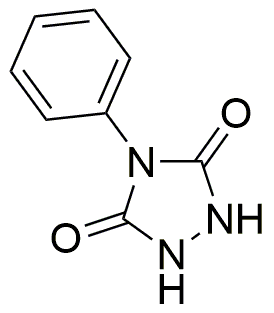4-Phenylurazole is widely utilized in research focused on:
- Agricultural Chemistry: It serves as a potent herbicide, effectively controlling weed growth in various crops, thus enhancing agricultural productivity.
- Pharmaceutical Development: This compound is explored for its potential in developing anti-inflammatory and analgesic medications, offering alternatives to traditional pain relief options.
- Biochemistry: Researchers use it as a biochemical probe to study enzyme activities, providing insights into metabolic pathways and potential therapeutic targets.
- Polymer Science: It acts as a stabilizer in polymer formulations, improving the durability and performance of materials used in coatings and plastics.
- Environmental Science: The compound is investigated for its role in bioremediation processes, helping to break down pollutants in soil and water, thus promoting environmental sustainability.
Informations générales
Propriétés
Sécurité et réglementation
Applications
4-Phenylurazole is widely utilized in research focused on:
- Agricultural Chemistry: It serves as a potent herbicide, effectively controlling weed growth in various crops, thus enhancing agricultural productivity.
- Pharmaceutical Development: This compound is explored for its potential in developing anti-inflammatory and analgesic medications, offering alternatives to traditional pain relief options.
- Biochemistry: Researchers use it as a biochemical probe to study enzyme activities, providing insights into metabolic pathways and potential therapeutic targets.
- Polymer Science: It acts as a stabilizer in polymer formulations, improving the durability and performance of materials used in coatings and plastics.
- Environmental Science: The compound is investigated for its role in bioremediation processes, helping to break down pollutants in soil and water, thus promoting environmental sustainability.
Documents
Fiches de données de sécurité (FDS)
La FDS fournit des informations de sécurité complètes sur la manipulation, le stockage et l’élimination du produit.
Spécifications du produit (PS)
Le PS fournit une description complète des propriétés du produit, notamment sa composition chimique, son état physique, sa pureté et les exigences de stockage. Il détaille également les plages de qualité acceptables et les applications prévues du produit.
Certificats d'analyse (COA)
Recherchez des certificats d'analyse (COA) en saisissant le numéro de lot du produit. Les numéros de lot et de lot se trouvent sur l'étiquette d'un produit, après les mots « Lot » ou « Lot de fabrication ».
Numéro de catalogue
Numéro de lot/série
Certificats d'origine (COO)
Ce certificat d'exploitation confirme le pays dans lequel le produit a été fabriqué, et détaille également les matériaux et composants utilisés et s'il est issu de sources naturelles, synthétiques ou autres sources spécifiques. Ce certificat peut être requis pour les douanes, le commerce et la conformité réglementaire.
Numéro de catalogue
Numéro de lot/série
Fiches de données de sécurité (FDS)
La FDS fournit des informations de sécurité complètes sur la manipulation, le stockage et l’élimination du produit.
DownloadSpécifications du produit (PS)
Le PS fournit une description complète des propriétés du produit, notamment sa composition chimique, son état physique, sa pureté et les exigences de stockage. Il détaille également les plages de qualité acceptables et les applications prévues du produit.
DownloadCertificats d'analyse (COA)
Recherchez des certificats d'analyse (COA) en saisissant le numéro de lot du produit. Les numéros de lot et de lot se trouvent sur l'étiquette d'un produit, après les mots « Lot » ou « Lot de fabrication ».
Numéro de catalogue
Numéro de lot/série
Certificats d'origine (COO)
Ce certificat d'exploitation confirme le pays dans lequel le produit a été fabriqué, et détaille également les matériaux et composants utilisés et s'il est issu de sources naturelles, synthétiques ou autres sources spécifiques. Ce certificat peut être requis pour les douanes, le commerce et la conformité réglementaire.


